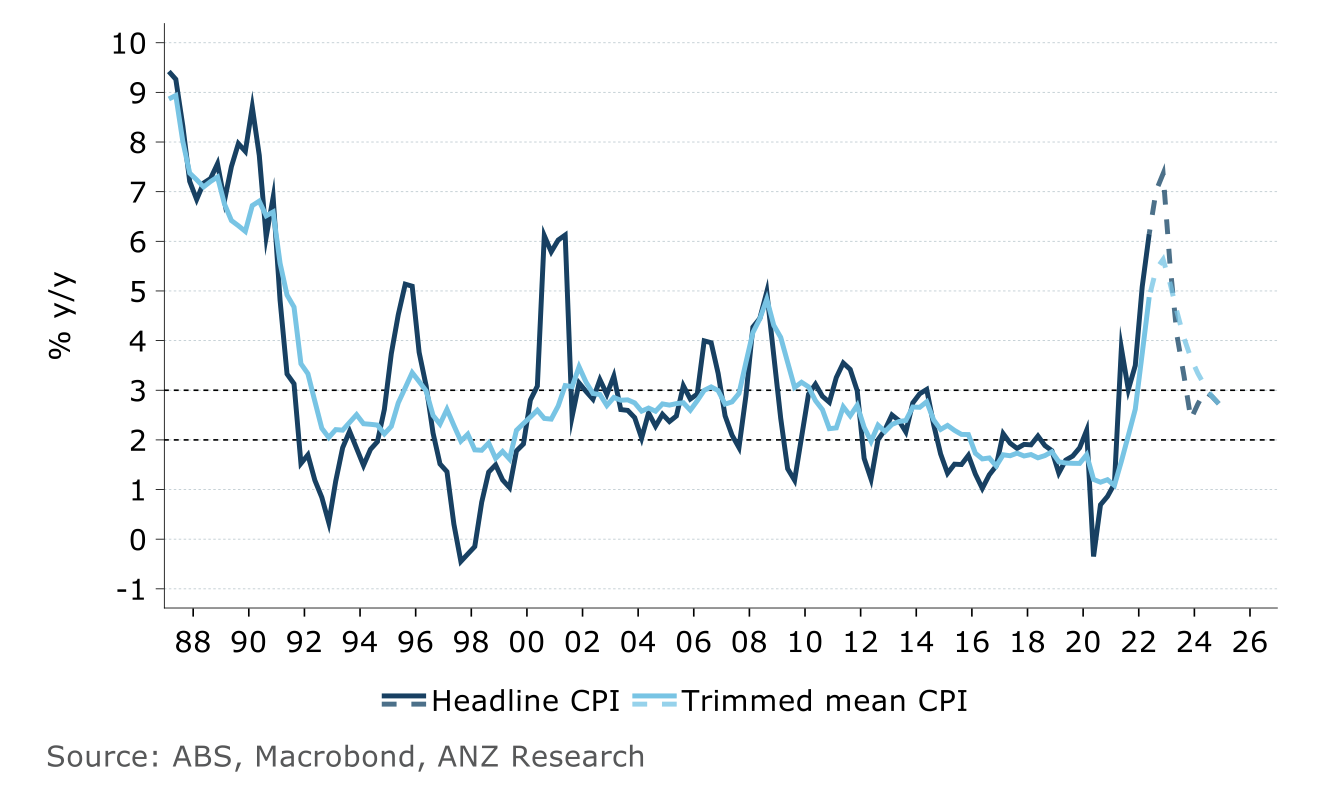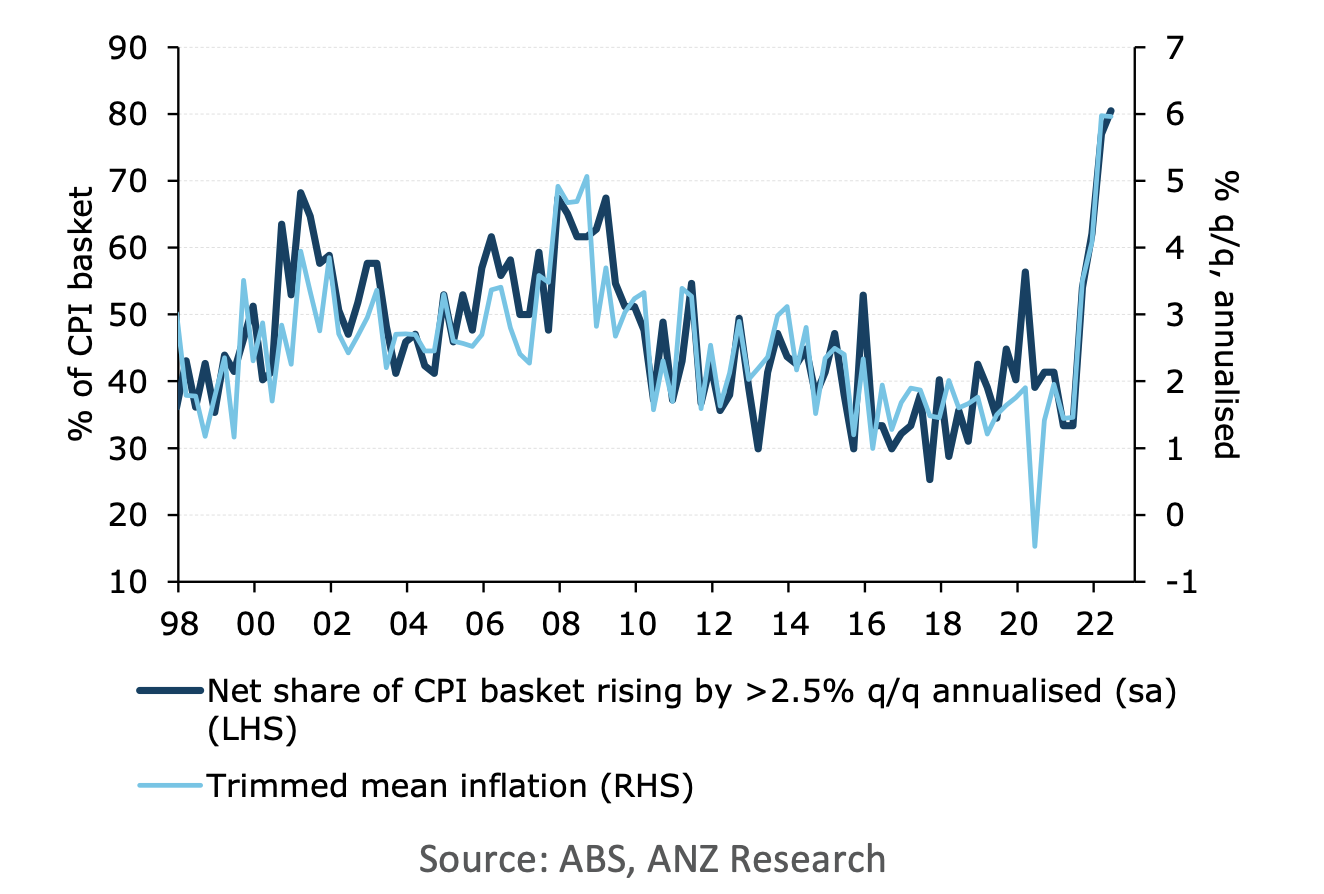-
Australia's annual headline inflation hit 6.1 per cent in Q2 this year, which is the highest since the early nineties (outside the introduction of the Goods and Services Tax in 2000).
{CF_VIDEO}
While we may be past the peak in quarterly inflation, annual inflation in Australia is likely to keep rising. ANZ Research is forecasting a peak of 7.4 per cent by the end of 2022.
“Wages aren’t a key driver of inflation in Australia so far but demand is, which is a big reason why the RBA is lifting rates so quickly.”While we may be past the peak in quarterly inflation, annual inflation in Australia is likely to keep rising. ANZ Research is forecasting a peak of 7.4 per cent by the end of 2022.
Headline and trimmed mean inflation forecasts
{CF_IMAGE}
Higher inflation disproportionately affects lower income households, particularly when inflation for non-discretionary goods and services is almost double that of discretionary goods and services, as we’re currently experiencing.
Inflation in Australia is lower and took longer to accelerate than many other countries around the world. While the rate of inflation is 6.1 per cent in Australia, in the US it's 8.5 per cent, in New Zealand it’s 7.3 per cent and in the UK it's over 10 per cent.
Inflation by country
{CF_IMAGE}
There have been some common global factors particularly with very high commodity prices and supply constraints stemming from Russia’s invasion of Ukraine and China’s ongoing Covid lockdowns. On the supply side, Australia has had to deal with the extensive flooding we've seen over the first half of this year.
Demand is also a key driver of inflation in Australia. Even though tradables inflation has been running at about 8 per cent over the past year, non-tradables inflation is running at over 5 per cent which is the strongest we've seen in many years.
Tradables and non-tradables inflation
{CF_IMAGE}
Inflation has been quite broad based across Australia's CPI (consumer price index) basket with about 80 per cent of all goods and services seeing annualised growth of 2.5 per cent or more in the second quarter – that is in the middle of the RBA's target band of 2 to 3 per cent.
The diffusion index shows broadening price pressures
{CF_IMAGE}
Wages aren’t a key driver of inflation in Australia so far but demand is, which is a big reason why the RBA is lifting rates so quickly. While we think annual inflation will slow through next year, we think it's going to take quite a while to come down and get back within the RBA's target band of 2 to 3 per cent.
Globally and domestically, there have been some shifts in the drivers of inflation. For example, if we're past the peak in globalisation with more barriers to movement of goods, services and people around the world, that's inflationary.
After several years of businesses focussing on efficiency and driving down costs, we’re seeing them start to think more about building resiliency into their operations and their supply chains – mainly in response to the shocks we've seen in the form of bushfires, floods, COVID and the invasion of Ukraine. Increasingly we’re also seeing businesses pass on their cost rises to consumers.
Global supply chain pressure index
{CF_IMAGE}
Inflation in Australia is too high at the moment, far outpacing wage growth. Real wages have fallen 3.3 per cent over the past year and the purchasing power of households is falling.
The RBA wants inflation to get lower - but not too low when we consider for several years leading up to the pandemic inflation was undershooting the RBA's target of 2 to 3 per cent. This reflected a period of weak wage growth, stagnant living standards and soft consumer demand which undermined demand for businesses’ goods and services.
We think inflation is going to be quite sticky and it won't be until the second half of 2024 that we see underlying inflation get back into the RBA’s target band of 2 to 3 per cent.
Catherine Birch is a Senior Economist at ANZ
The views and opinions expressed in this communication are those of the author and may not necessarily state or reflect those of ANZ.
-
-
-
-
-
-
anzcomau:Bluenotes/global-economy,anzcomau:Bluenotes/Economics
Economic shorts: Inflation insights
2022-08-26
/content/dam/anzcomau/bluenotes/images/articles/2022/August/Screen Shot 2022-08-26 at 9.40.39 am.png
EDITOR'S PICKS
-
House prices are forecasted to drop 15 to 20 per cent due to higher interest rates cutting back borrowing power.
18 August 2022 -
While inflation is on the rise a strong labour market may insulate the Australian economy from a sharp deterioration.
5 August 2022





